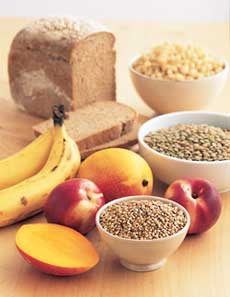fitness news
![]() ,
,![]()
Font size Weight Management
The Low-Glycemic Index Diet: A Better Way to Lose Weight?
– Reported, June 27, 2012
 (Ivanhoe Newswire) A new study challenges the notion that a calorie is just a calorie by finding that diets reducing the surge in blood sugar after a meal are preferable for weight loss, ultimately praising the low-glycemic index diet.
(Ivanhoe Newswire) A new study challenges the notion that a calorie is just a calorie by finding that diets reducing the surge in blood sugar after a meal are preferable for weight loss, ultimately praising the low-glycemic index diet.
Many people are emotionally distressed after regaining weight that took so long to lose in the first place; only one in six overweight people will maintain even 10-percent of their weight loss long-term. Regaining weight as often been attributed to a decline in motivation and maintaining an exercise and diet regimen. After people lose weight, the rate at which people burn calories (energy expenditure) decreases, reflecting a slower metabolism. This explains why people tend to regain lost weight.
In order to keep energy expenditure at a high rate, the study researchers suggest a low-glycemic load diet as a more effective way to burn calories at a higher rate after weight loss. “We’ve found that, contrary to nutritional dogma, all calories are not created equal,” David Ludwig, MD, director of both the New Balance Foundation Obesity Prevention Center and the Optimal Weight for Life Clinic at Boston Children’s Hospital, was quoted as saying.
“Total calories burned plummeted by 300 calories on the low fat diet compared to the low carbohydrate diet, which would equal the number of calories typically burned in an hour of moderate-intensity physical activity,” he was quoted as saying.
The study recruited 21 adult participants ages 18-40 years old who were first directed to lose 10 to 15 percent of their body weight. After weight stabilization, each participant completed all three of the following diets in random order, each for four weeks at a time. The randomized crossover design allowed for rigorous observation of how each diet affected all participants, regardless of the order in which they were consumed:
A low-fat diet: reduces dietary fat and emphasizes whole grain products and a variety of fruits and vegetables. Comprised of 60% of daily calories from carbohydrates, 20% from fat, and 20% from protein
A low-glycemic index diet: made up of minimally processed grains, vegetables, healthy fats, legumes and fruits. Comprised of 40% of daily calories from carbohydrates, 40% from fat, and 20% from protein. Low-glycemic index carbohydrates digest slowly, keeping blood sugar and hormones stable after a meal
A low-carbohydrate diet: modeled after the Atkins diet, this diet was comprised of 10% of daily calories from carbohydrates, 60% from fat and 30% from protein
Each participant was measured with state-of-the-art methods, including stable isotopes to measure participants total energy expenditure as they followed each diet. Additionally, each of the three diets fell within the normal healthy range of 10-35% of daily calories from protein.
The study found that the low-carbohydrate diet showed the greatest improvement of metabolism, but adversely increased patients cortisol levels, which can lead to insulin resistance and cardiovascular disease. It also raised C-reactive protein levels, which also increases risk of cardiovascular disease.
Additionally, although recommended by the U.S. Government and Heart Association, a low-fat diet caused the greatest decrease in energy expenditure, an unhealthy lipid pattern, and insulin resistance.
“In addition to the benefits noted in this study, we believe that low-glycemic-index diets are easier to stick to on a day-to-day basis, compared to low-carb and low-fat diets, which many people find limiting,” Cara Ebbeling, PhD, study leader and associate director of the New Balance Foundation Obesity Prevention Center, was quoted as saying. “Unlike low-fat and low-very-carbohydrate diets, a low-glycemic-index diet doesn’t eliminate entire classes of food, likely making it easier to follow and more sustainable.”
Some examples of foods that rank low on the glycemic index are raw carrots, peanuts, raw apple, grapefruit, peas, skim milk, kidney beans and lentils.
Source: JAMA, June 2012